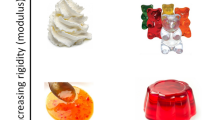Abstract
In the present work the effect of storage conditions of egg on rheological properties of Liquid Whole Egg (LWE) prepared from stored eggs were evaluated using a Brookfield. Newtonian model and Ostwald-of-Waele (Power Law) model were fitted to the rheological data obtained by experiments, both represented a good adjustment to the rheological data. The Newtonian model has shown an R2value between 0.984 and 0.993 (P < 0.05) and 0.991 and 0.995 (P < 0.05) for LWE samples prepared from eggs stored at room temperatures and refrigerated temperatures. The Ostwald-of-Waele (Power Law) resulted in the best adjustment, presenting an average R2 values higher than 0.99 in all the cases and further statistical analysis showed that power law model was appropriate to explain the correct rheological behaviour of LWE prepared from stored eggs. All the LWE samples showed pseudoplastic and thixiotropic behaviour in the experimental conditions.





Similar content being viewed by others
References
ACIAR (1998) Measurements and maintenance of duck and hen egg quality in Vietnam. Australian Centre for International Agricultural Research, Research note RN 23 12/99
Akyurek H, Okur AA (2009) Effect of storage time, temperature and hen age on egg quality in free range layer hen. J Anim Vet Adv 8(10):1953–1958
Briggs JL, Steffe JF (1997) Using Brookfield data and the Mitschka method to evaluate power law foods. J Text Stud 28:517–522
Chen C, Morey RV (1989) Comparison of four ERH/EMC equations. Trans ASAE 32:983–990
Cornford SJ, Parkinson TC, Robb J (1969) Rheological characteristics of processed whole egg. J Food Technol 4:353
Decuypere E, Tona K, Bruggeman V, Bamelis F (2001) The day-old chick: acrucial hinge between breeders and broilers. World’s Poult Sci J 57:127–137
Doymaz I (2006) Thin-layer drying behaviour of mint leaves. J Food Eng 74(3):370–375
Hamid-Samimi MH, Swartzel KR (1985) Maximum change in physical and quality parameters of fluid foods during continuous flow heating: application to liquid whole egg. J Food Process Preserv 8:225–239
Hamid Samimi M, Swartzel KR, Ball HR Jr (1984) Flow behavior of liquid whole egg during Thermal treatments. J Food Sci 49:132–136
Harrison LJ, Cunningham FE (1986) Influence of frozen storage time on properties of salted yolk and its functionality in mayonnaise. J Food Qual 9:167
Herald TJ, Osorio FA, Smith DM (1989) Rheological properties of pasteurized liquid whole egg during frozen storage. J Food Sci 54(1):35–38
Jirangrat W, Torrico D, No J, No HK, Prinyawiwatkul W (2010) Effects of mineral oil coating on internal quality of chicken eggs under refrigerated storage. Int J Food Sci Technol 45(3):490–495
Mitschka P (1982) Simple conversion of Brookfield R.V.T readings into viscosity functions. Rheol Acta 21:207–209
Palmer HH, Ijichi K, Cimio SL, Roff H (1969) Salted egg yolks. 1. Viscosity and performance of pasteurized and frozen samples. Food Technol 23:1480
Punidadas P, McKellar RC (1999) Selected physical properties of liquid egg products at pasteurization temperatures. J Food Process Preserv 23:153–168
Raji AO, Aliyu J, Igwebuike JU, Chiroma S (2009) Effect of storage methods and time on egg quality traits of laying hens in a hot dry climate. ARPN J Agr Biol Sci 4(4):1–7
Rao MA (1995) Engineering properties of foods, rheological properties of fluid foods. Marcel Dekker, New York, pp 1–53
Rao MA (1999) Rheology of fluid and semisolid foods. Aspen Publishers, Inc., Gaithersburg
Samli HE, Agma A, Senkoylu N (2005) Effect of storage time and temperature on egg quality in old laying hens. J Appl Poult Res 14:548–553
Scott TA, Silversides FG (2000) The effect of storage and strain of hen on egg quality. Poult Sci 79:1725–1729
Silversides FG, Twizeyimana F, Villeneuve P (1993) Research note: a study relating to the validity of the Haugh unit correction for egg weight in fresh eggs. Poult Sci 72:760–764
Steffe JF (1996) Rheological methods in food process engineering. Freeman, Michigan
Torten J, Eisenberg H (1982) Studies on colloidal properties of whole egg magma. J Food Sci 47:1423
Windson C, Haminiuk I, Maciel GM, Plata-Oviedo MS, Quenehenn A, Scheer AP (2009) Study of the rheological parameters of honey using the Mitschka method. Int J Food Eng 5(3):1–9
Author information
Authors and Affiliations
Corresponding author
Rights and permissions
About this article
Cite this article
Singh, J., Sharma, H.K., Premi, M. et al. Effect of storage conditions of egg on rheological properties of liquid whole egg. J Food Sci Technol 51, 543–550 (2014). https://doi.org/10.1007/s13197-011-0509-7
Revised:
Accepted:
Published:
Issue Date:
DOI: https://doi.org/10.1007/s13197-011-0509-7




